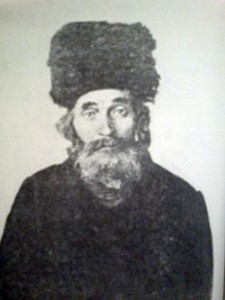Shlomo Radomsker and Reb Elimelech
Wednesday, February 26th, 2014Click here for Hebrew text.
The Yahrzeit of Rabbi Shlomo of Radomsk (1801-1866) is commemorated on the 29th of Adar. The following meise / hasidic tale appeared in Sefer HaHasidut, Meah Tzadikim, Raphael, Yitzchak, 1961, Tel Aviv. (Freely translated by Gabbai Seth Fishman.)
Reb Dovid, the Teacher of Children
Although Rebbe Elimelech of Lizhensk had died before Rabbi Shlomo HaKohen was born, his legacy was still a big influence on the latter’s life. With regularity, Reb Shlomo used to journey to Rebbe Elimelech’s grave.
Once it happened that Rabbi Shlomo was traveling, passing through the small town of Zolynia in Galicia. While on this trip, when he reached the cemetery in Zolynia, he asked the Hasidim to locate the grave of the Hasid, Reb Dovid.
The Hasidim supposed it would be an easily found monument, (as one would expect for an honored sage), however they could not find one with this name.
Eventually, though, they found the grave: There was a small tombstone upon which was written:
“Here lies Reb Dovid, Teacher of Children” – and nothing more.
Rabbi Shlomo went to the grave and there he recited Psalms.
Rabbi Shlomo told them about him:
“For Rebbe Elimelech, z’tz’l, who had loved him greatly, this Reb Dovid, z’l, was extremely important.
“Once, the Rav Rebbe Elimelech z’tz’l made a point to go to him and there, he was to eat a meal for Melaveh Malkah (Farewell Shabbos). But since Reb Dovid was very poor, he didn’t have something fitting to give the Rav Rebbe Elimelech to eat.
“His wife took a kneading vessel and, for the Melaveh Malkah, from the dough that had come together through the kneading she made ‘Kleiskloch‘ (perhaps similar to Polish gnocchi).
“She prayed to Hashem yitbarach that the food she was preparing for the Rav Rebbe Elimelech would be good, like meat, and her prayer was received. The Rav Rebbe Elimelech greatly praised her cooking.”
And here’s why it says, ‘Teacher of Children’:
“After Reb Dovid died, it’s widely known that when there was a big wedding in Ostila, the Tzaddikim would announce:
“‘Anyone who has not repaired the sin of youth should not dance at the wedding! But if Reb Dovid, z’l, had been here, he would have been dancing at the wedding!‘”
(Shlomo’s Tent)
